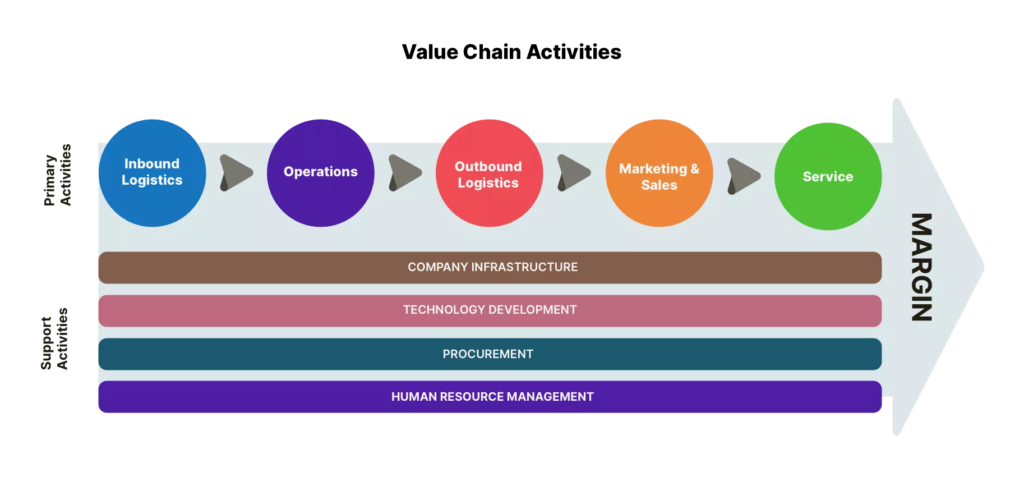Think of every little thing you do to create your product or offer your service as part of your value chain. Don’t worry, it’s not some fancy jargon – it’s just a way of looking at all the steps that go into making your product or service awesome. Each step? Absolutely crucial. Why? Because that’s where the magic (or chaos) happens.
We’re talking about a way of supercharging your business by making it leaner and way more profitable.
Think of it this way: Your business is like a delicious, juicy burger. Each ingredient – from the perfectly toasted bun to the secret sauce – plays a role in creating an amazing taste in the buds of your customers.

But what if your lettuce is wilted? Or your patty is drier than a desert?
A total burger disaster!
Value chain analysis is like being a super-strict burger inspector who examines every single step of your business, from getting the ingredients (sourcing) to serving up that masterpiece (customer service).
During this inspection, you’re gonna figure out:
A recent survey by McKinsey found that 70% of companies are struggling to scale their digital operations, showing how important efficient value chains are especially for e-commerce or digital services.
The purpose of the value chain analysis is to increase efficiency for the business at the lowest possible cost without having to reduce the quality of your product.
It also helps you identify opportunities to differentiate yourself and become the obvious choice for customers.
When customers are happy with your product, it means more money for you because you are creating real value for them. This causes them to stick around, tell their friends, and altogether become raving fans who shower you with money. What’s not to love?
Did you know that some businesses are using AI to predict problems before they happen, making their value chains 20% more efficient? Now that’s what I call future-proofing!
This proves to you that analyzing each step of your business can help you find ways to cut costs, improve quality, and make your customers super happy. Think of it as a win-win situation for everyone.

Imagine your business as a giant machine, churning out amazing products or services for your customers. But just like any machine, it’s made up of a bunch of smaller parts working together. That’s where value chain analysis comes in – it helps you understand all the different steps that make your business tick.
Michael Porter first described the concept of value chain in his 1985 best-seller, Competitive Advantage: Creating and Sustaining Superior Performance. He identified two main types of activities that turn raw materials into satisfied customers: primary and secondary.
These are the main activities of your value chain, directly creating the product or service you offer. They’re like the chefs in the kitchen, transforming ingredients into delicious dishes:
Inbound Logistics
This is all about getting the good stuff you need – the raw materials and components that make up your product. Think of it like the process of receiving vegetables, top-notch flour, and the perfect eggs for your bakery.
Activities here include managing suppliers, warehousing, and keeping track of inventory. Speaking of bakeries, a small one in Texas used an AI inventory system to slash waste by 30% and boost revenue by a whopping 25%! See, efficiency is a recipe for success!
Operations
Here’s where the magic happens! Raw materials are transformed into your amazing product. This could involve anything from operating machinery and assembling parts to packaging and testing your creation.
Outbound Logistics
Once your product is ready to roll, it’s time to get it to your customers. This involves warehousing finished goods, managing deliveries, and making sure everything arrives safely.
Marketing and Sales
Now it’s showtime! You need to spread the word about your fantastic product and convince customers to buy it.
The activities in this step of the value chain include marketing, promotion, sales force, quoting, channel selection, channel relations, and pricing strategy.
Service
The job doesn’t stop after the sale! Great service keeps customers happy and coming back for more. This could include installation, training, repairs, and providing good customer support.
The more you focus on making these primary activities as efficient and quick as possible, the more successful your company will be. They have the biggest impact on the value your customers experience, which translates to a bigger competitive advantage for you.
These are the behind-the-scenes heroes that help the primary activities shine. They provide the foundation for everything to run smoothly:
Procurement
Procurement includes the purchase of raw materials, parts, equipment, and all tangible assets needed to produce a good or provide a service.
This is all about finding the best deals on the ingredients (or raw materials) you need for your product. It involves things like negotiating with suppliers and building strong relationships with them.
Technological Development
No company can continue thriving without adequate technological development. This can vary from the technology needed to optimize various processes within the organization to those directly needed to create a good or service.
The increasing adoption of automation and artificial intelligence (AI) is transforming value chains.
Small businesses that embrace these technologies can automate repetitive tasks, improve efficiency, and gain a competitive advantage.
We can incorporate insights into how small businesses can leverage automation and AI in their value chains, such as using AI-powered chatbots for customer service, automating inventory management, or implementing robotic process automation for repetitive tasks. This emphasizes the importance of staying ahead of the curve in terms of technology adoption.
Human Resources Management
You need a talented team to keep everything running smoothly. HR takes care of recruiting, hiring, and training the all-star employees who make your business amazing.
Infrastructure
This supporting activity is concerned with a company’s organizational framework. It deals with how the company operates, determines how activities are carried out, and ultimately lays out the chain of command as well as how each department relates to the others.
Infrastructural activities include management, quality assurance, overhead, financing, and public relations.
It’s understandable that not every business will have exactly the same set of activities. A tiny bakery won’t need a huge HR department like a giant corporation. The key is to identify the activities that are most important for your specific business.
Identify any of the primary activities that are specific to your business and write them down. These typically include the main steps involved in getting your product or service from “idea” to “happy customer”. List them out, step-by-step:
Support activities assist the primary activities and include:
For each primary and support activity, consider the following:
Identify Cost Drivers
Figure out what makes costs increase or decrease for each activity.
Evaluate Value Creation
Assess how each activity adds value to the product or service and contributes to customer satisfaction and competitive advantage.
Ask yourself, does this activity create a clear benefit for your customer? Does it enhance the product’s functionality and features or contribute to a positive customer experience?
Are there activities that don’t contribute directly to customer value? Maybe you’re offering unnecessary features or providing a level of service that customers don’t necessarily value.
Identifying these gaps allows you to streamline your operations and focus resources on what truly matters.
Compare the performance of each activity against industry standards (if you find them) or best practices.
Based on the analysis, identify areas where you can crank up the efficiency and really impress your customers.
Slashing Costs
Let’s face it, saving money without sacrificing quality is every business owner’s dream. Here’s where you can get creative! Look for ways to lower costs without compromising quality.
Can you automate some tasks to free up your team’s time? Can some processes be streamlined to cut down on waste?
Is it possible to renegotiate with suppliers to score better deals on materials?
Optimizing these areas means you can spend less and focus your resources on the things that bring in the most revenue and value for your customers.
Think about Costco, the warehouse shopping giant. They don’t spend a ton of money on traditional advertising. Instead, they focus on offering exceptional value to their members – think rock-bottom prices and top-notch products. This lets them reinvest a bigger chunk of their budget back into the business, rather than blowing it all on flashy marketing campaigns.
A small bakery in New York discovered a similar win-win. By switching to locally sourced ingredients, they not only reduced their costs but also saw a whopping 25% jump in customer satisfaction! See, everyone wins!
Boosting Value
Let’s ramp up the value you offer to your customers. This could involve jazzing up your product features, taking customer service to the next level, or investing in employee training.
Don’t forget, value can also be added by making sure every step of your production process meets the highest quality standards. Consistent quality keeps your customers happy, and happy customers become loyal customers!
Standing Out from the Crowd
What makes your business special? Is it your cutting-edge technology, phenomenal customer service, or an unshakeable brand reputation? Identify your unique strengths to gain a competitive edge.
You can also gain a competitive advantage through social media to spread the word about your awesomeness! Platforms like TikTok, Facebook, and Twitter are all great places to join trending challenges and showcase your brand in a fun and engaging way.
Short videos, and eye-catching pictures – get creative and let your personality shine!
Now that you’ve identified areas for improvement, it’s time to turn those ideas into a reality! Here’s how to craft a rock-solid action plan:
Review Performance
Regularly review the performance of the value chain activities to ensure that improvements are yielding the desired results.
A recent survey revealed that businesses focusing on value chain optimization experienced a 20% increase in overall efficiency and a 15% reduction in costs within a year – that’s some serious progress!
Refine
The business world is constantly changing, so be prepared to adapt! Use customer feedback, stay on top of market trends, and keep an eye out for new opportunities.
Here’s a cool fact: A study by Deloitte found that companies with super-flexible and responsive value chains were 40% more likely to report higher-than-average profits. This shows how important it is to be adaptable and keep your value chain moving with the times.
We have tons of actionable advice to help small businesses build more agile value chains. Think about adopting lean (cost-effective) practices, implementing flexible production systems, and using data analytics to make real-time decisions. See how this all connects? A quick value chain directly translates to increased profitability!
Amazon, Apple, McDonald’s, and Coca-Cola—they’ve mastered value chain analysis. Why not borrow a page from their playbooks?
Amazon’s e-commerce prowess, Apple’s tech wizardry, McDonald’s efficiency, and Coca-Cola’s brand power—all case studies you can use. Read more and adapt their strategies to your small biz.
Follow these links for deeper dives into their success stories:
Remember, heroes—strip down these steps, use them, and tweak them. Get efficient. Get competitive. And most importantly, get growing.

Email subscription is available ONLY TODAY (oh, okay, and tomorrow).
Surely, we respect your inbox! Unsubscription works every day.

We’d love to tailor your experience — which of these best describes you?